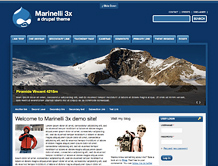Drupal can be complicated, but with that comes incredible power and flexibility. The Drupal theme system creates the perfect storm of complexity, UX and control from the interface. Drupal theming isn't easy, but even the layman can do incredible things through pointing and clicking. And if you want to do things The Drupal Way, it's vitally important to learn to let Drupal do what it can from the interface (before even thinking about touching code).
This introductory guide requires no code knowledge whatsoever and will be outlined more like a hitlist than step-by-step tutorial. So without further ado, let's chat about some of the great resources you have to get started!
Themes
This may be a no-brainer, but there are some great themes you can get from Drupal.org that may already have what you're looking for. Sort and filter the list however you want, starting with the version of Drupal you're using. By default, the list is sorted by "most installed", which can be handy for discovering new themes (and modules!) that are becoming popular.

- Corolla - This is one I found about a year ago and has been my usual go-to suggestion for people who want a lot of features in a slick interface without the hassle of writing your own code. This one's based on the AdaptiveTheme base theme. You may also like Sky, Pixture Reloaded or AT Commerce. When you're ready for the next level, you can make your own theme by building on a base theme.

-
Marinelli - This is the most popular production theme on Drupal.org, which really says something. It appears to be pretty feature-rich and could very well be a good place to start (though I've not used it myself). Depending what look you're going for, you may also like Danland, BlueMasters or Corporate Clean.
- Seven - This administration theme is already included in Drupal 7 core, so no need to download unless you're running Drupal 6. It's minimal, but is intended to be a very clean experience for administrators on configuration pages, when editing nodes, etc. There are some alternatives if you'd prefer a less minimalist take on administration. The most popular alternatives are RootCandy and Rubik.
Tools for Layout
Maybe you have a great theme, but what happens when you want to put content on the sidebar, reorder fields, or control layout per-content type? Traditionally, the only way to put content in a new place on your Drupal site was to add new regions, new template files (tpl.php), and use blocks. Unfortunately this practice often created inflexible layouts, ugly code and headaches for anyone who wanted to change something. It also required knowing the code and guessing where it was changed.
Nowadays, there are many new options for controlling layout directly from the UI. Like many things in Drupal, there are many different ways to accomplish the same goal. There is no absolute solution, but you may find that one or all of these solutions make the most sense.
- Display Suite - This module lives on the "Manage displays" tab of your content types. It's perfect whenever you want to control layout of fields per content type, control more specific styles for fields and labels, etc. — all without having to add any .tpl.php files or modify any code. DS can be a huge time saver for quick fixes, and can allow you to dig in deep and dramatically change the way your site looks.
- Context - One of the biggest problems with blocks is that they're dumb. They're not aware of things around them and they're really only able to appear in one particular region at a time. The Context module tries to solve that by setting conditions and reactions for various parts of your site (such as blocks or menus).
- Panels - Chapter Three uses Panels extensively for the depth of its features, fine-grained control,and tight integration with modules such as Views. As a themer, I'm able to create custom layouts in Panels for one site and use them across any other site where I use Panels. We at Chapter Three write many blog posts about Panels and given sessions at camps and cons: Panels for Themers (creating highly flexible layouts, created Panopoly and Open Academy, etc. We're definitely sold.
Once you get into theming, you find that it runs deep. Want to change something about the way Drupal looks? You can. Without learning to code, your options may be limited, but everyone has to start somewhere. To learn more, check out Leveling Up Your Themer: Lvl 1.
This is part 0 of the Leveling Up Your Themer series: a multi-part blog post introducing popular theming topics to help you level yourself up as a themer.
Sign up for the mailing list to be notified when there are new posts in this series and follow @chapter_three on twitter for all of the latest updates!